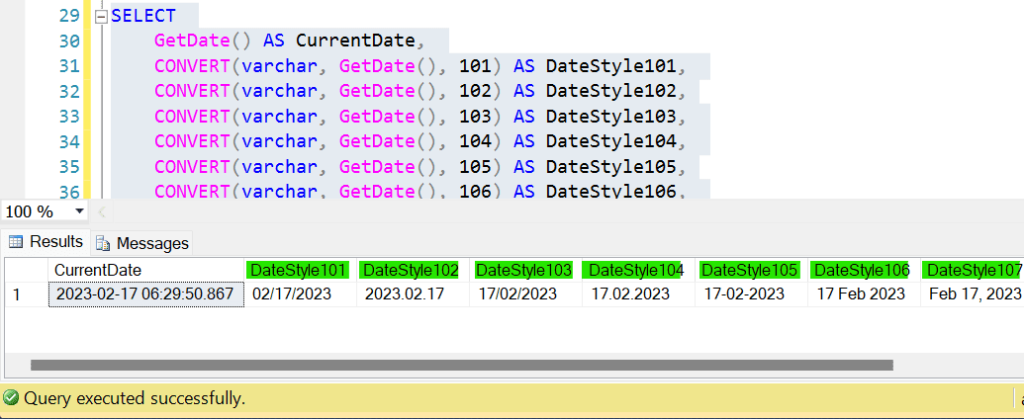As a SQL Server developer, you may encounter situations where you must convert data types from one form to another. The SQL Server CONVERT function can help you achieve this task by changing the data type of an expression to another data type.
This article will cover everything you need to know about the SQL Server CONVERT function. I’ll explain the function and how to use it and provide code examples in SQL Server. We’ll also compare the CONVERT function to similar functions in SQL Server, like CAST, FORMAT, and PARSE.

Table of Contents
- 1 What is a CONVERT function in SQL Server?
- 2 How to Use SQL Server CONVERT Function
- 3 Implicit and explicit data type conversion
- 4 SQL CONVERT function example
- 5 Using CONVERT Function with the GetDate() Function
- 6 Alternatives to the CONVERT function
- 7 FAQs
- 7.1 Q: What is the CONVERT function in SQL Server? A: The CONVERT
- 7.2 Q: What data types can be converted using the CONVERT function in SQL Server?
- 7.3 Q: How do you use the SQL Server CONVERT function?
- 7.4 Q: What is the difference between implicit and explicit data type conversion in SQL Server?
- 7.5 Q: What are some alternatives to the CONVERT function in SQL Server?
- 7.6 Q: What is the difference between the CONVERT and CAST functions in SQL Server?
- 7.7 Related
What is a CONVERT function in SQL Server?
The CONVERT function in SQL Server changes the data type of an expression. The function takes three arguments: the target data type, the expression to be converted, and an optional style argument.
The target data type can be any valid SQL Server data type, including numeric, character, and date/time data types. The expression to be converted can be any valid expression that returns a value. The style argument is optional and specifies the formatting style used when converting data types.
How to Use SQL Server CONVERT Function
The syntax for the SQL Server CONVERT function is as follows:
Syntax
CONVERT ( data_type [ ( length ) ], expression [ , style ] )
Let’s break down the syntax:
data_type: This is the target data type you want to convert the expression. It can be any valid SQL Server data type, including numeric, character, and date/time data types.length: This argument is optional and specifies the length of the target data type. For example, if the target data type is varchar, you can specify the maximum length of the string.expression: This is the expression you want to convert to the target data type. It can be any valid expression that returns a value.style: This argument is optional and specifies the formatting style used when converting data types.
Implicit and explicit data type conversion
In SQL Server, there are two types of data type conversions: implicit and explicit. Implicit conversion happens automatically when SQL Server converts one data type to another without being told to do so. Explicit conversion occurs when you use a function to convert data types explicitly.
Explicit conversion is necessary when changing the data type of a column or variable. The CONVERT function is one of the most commonly used functions for explicit data type conversion in SQL Server.
SQL CONVERT function example
Here are some examples of how to use the CONVERT function in SQL Server.
Example 1: Convert date and time data types
In this example, we’ll convert a date data type to a varchar data type using the CONVERT function. We’ll also specify the formatting style when converting the data type.
SELECT CONVERT(varchar(10), GETDATE(), 101) AS [Date]
Output:
Date
-----------
02/17/2023
We used the GETDATE() function in this example to get the current date and time. We then used the CONVERT function to convert the date to a varchar data type. We specified the formatting style 101, representing the format mm/dd/yyyy.
Example 2: Convert numeric data types
In this example, we’ll convert a numeric data type to a varchar data type using the CONVERT function. We’ll also specify the formatting style when converting the data type.
SELECT CONVERT(varchar(10), 12345.67, 1) AS [NumericToVarChar]
Output:
NumericToVarChar
-----------
12345.67
In this example, we used the CONVERT function to convert a numeric data type to a varchar data type. We specified the formatting style 1, which represents the format with commas and two decimal places.
Example 3: Convert money data types
In this example, we’ll convert a money data type to a varchar data type using the CONVERT function. We’ll also specify the formatting style when converting the data type.
SELECT CONVERT(varchar(10), 12345.67, 2) AS [Money]
Output:
Money
-----------
12345.67
In this example, we used the CONVERT function to convert a money data type to a varchar data type. We specified the formatting style 2, representing the format with commas and two decimal places.
Using CONVERT Function with the GetDate() Function
You can also use the CONVERT function with the GetDate() function in the SQL Server statement.
Here we are using CONVERT() function to modify the Date that has been provided in different formats.
Here is an example:
SELECT
GetDate() AS CurrentDate,
CONVERT(varchar, GetDate(), 101) AS DateStyle101,
CONVERT(varchar, GetDate(), 102) AS DateStyle102,
CONVERT(varchar, GetDate(), 103) AS DateStyle103,
CONVERT(varchar, GetDate(), 104) AS DateStyle104,
CONVERT(varchar, GetDate(), 105) AS DateStyle105,
CONVERT(varchar, GetDate(), 106) AS DateStyle106,
CONVERT(varchar, GetDate(), 107) AS DateStyle107,
CONVERT(varchar, GetDate(), 108) AS DateStyle108,
CONVERT(varchar, GetDate(), 109) AS DateStyle109,
CONVERT(varchar, GetDate(), 110) AS DateStyle110,
CONVERT(varchar, GetDate(), 111) AS DateStyle111,
CONVERT(varchar, GetDate(), 112) AS DateStyle112,
CONVERT(varchar, GetDate(), 113) AS DateStyle113,
CONVERT(varchar, GetDate(), 114) AS DateStyle114,
CONVERT(varchar, GetDate(), 120) AS DateStyle120,
CONVERT(varchar, GetDate(), 121) AS DateStyle121,
CONVERT(varchar, GetDate(), 126) AS DateStyle126,
CONVERT(varchar, GetDate(), 127) AS DateStyle127;
Output:

The following is the cheat table that includes the standard date/time format for each style code:
| Style Code | Standard | Output Format |
|---|---|---|
| 100 | Default | mon dd yyyy hh:miAM/PM |
| 101 | US | mm/dd/yyyy |
| 102 | ANSI | yyyy.mm.dd |
| 103 | British/French | dd/mm/yyyy |
| 104 | German | dd.mm.yyyy |
| 105 | Italian | dd-mm-yyyy |
| 106 | – | dd mon yyyy |
| 107 | – | Mon dd, yyyy |
| 108 | – | hh:mi:ss |
| 109 | Default + millisec | Mon dd yyyy hh:mi:ss:mmmAM/PM |
| 110 | USA | mm-dd-yyyy |
| 111 | JAPAN | yyyy/mm/dd |
| 112 | ISO | yyyymmdd |
| 113 | Europe (24 hour clock)> | dd mon yyyy hh:mi:ss |
| 114 | 24 hour clock | hh:mi:ss:mmm |
| 120 | ODBC canonical | yyyy-mm-dd hh:mi:ss |
| 121 | ODBC canonical (with milliseconds) | yyyy-mm-dd hh:mi:ss.mmm |
| 126 | ISO8601 | yyyy-mm-ddThh:mi:ss.mmmZ |
| 130 | Hijiri | dd mon yyyy hh:mi:ss:mmmAM |
| 131 | Hijiri | dd/mm/yy hh:mi:ss:mmmAM |
Alternatives to the CONVERT function
While the CONVERT function is the most commonly used function for explicit data type conversion in SQL Server, there are other functions you can use as well. Let’s take a look at some of them.
01. CAST function in SQL Server
The CAST function in SQL Server is another function you can use to convert data types. It works similarly to the CONVERT function but has a slightly different syntax.
Here is an example:
SELECT CAST('12345.67' AS money) AS [Money]
In this example, we used the CAST function to convert a varchar data type to a money data type.
02. FORMAT function in SQL Server
The FORMAT function in SQL Server is used to format data types in a specific way. We can use it to format numeric, date/time, and string data types.
Here is an example:
SELECT FORMAT(12345.67, 'C') AS [Currency]
We used the FORMAT function in this example to format a numeric data type as a currency.
03. PARSE function in SQL Server
The PARSE function in SQL Server converts a string to a specific data type. It’s useful when converting a string to a particular data type, but the string format may vary.
Here is an example:
SELECT PARSE('05/01/2023' AS date USING 'en-US') AS [Date]
In this example, we used the PARSE function to convert a string to a date data type. We specified the format of the string using the ‘en-US’ parameter.
FAQs
Q: What is the CONVERT function in SQL Server? A: The CONVERT
The CONVERT function in SQL Server converts an expression of one data type to another. It takes the form CONVERT(data_type, expression, style), where data_type specifies the target data type, expression specifies the input value, and style is an optional argument specifies how to format the output.
Q: What data types can be converted using the CONVERT function in SQL Server?
The CONVERT function in SQL Server converts a wide range of data types, including numeric data types, character data types, and date/time data types.
Q: How do you use the SQL Server CONVERT function?
To use the SQL Server CONVERT function, you need to specify the data type to which you want to convert the input value, along with the input value itself. You can also specify an optional style argument to control the output format of the converted value.
Q: What is the difference between implicit and explicit data type conversion in SQL Server?
Implicit data type conversion in SQL Server is automatic and occurs when a value is automatically converted from one data type to another without an explicit conversion function. On the other hand, explicit data type conversion requires using a conversion function like CONVERT to convert a value from one data type to another manually.
Q: What are some alternatives to the CONVERT function in SQL Server?
SQL Server provides several other conversion functions that can be used in place of the CONVERT function, including the CAST function, the FORMAT function, and the PARSE function.
Q: What is the difference between the CONVERT and CAST functions in SQL Server?
The CONVERT and CAST functions in SQL Server are used to convert data types but differ in their syntax and functionality. The CONVERT function allows for greater control over the output format of the converted value, while the CAST function provides a simpler, more straightforward way to convert data types.
Reference: W3School-SQL Server Convert Function()
You might want to read this too:
- Having VS Where Clause in SQL
- Stored Procedure in SQL Server – A Complete Guide [with Examples]
- SQL Server TRY_CAST() Function – Understanding TRY_CAST() in SQL with [Examples]
- Function vs Stored procedure in SQL Server
- Primary Key Constraint In SQL Server
- View In SQL | Types Of Views In SQL Server
- SQL Server Trigger Update, Insert, Delete Examples
- SQL pivot tables
- Different ways to delete duplicate rows in SQL Server
- UNION vs UNION ALL in SQL SERVER
- SQL Server Try Catch: Error Handling in SQL Server With [Examples]
- Group by Month in SQL
- Types of Joins in SQL Server
Let others know about this post by sharing it and leaving your thoughts in the comments section.
- C# 12 New Features in 2025: What’s New with .NET 8 - April 11, 2025
- Difference Between WCF and Web API with Examples: A Comprehensive Guide - March 27, 2025
- PUT vs PATCH vs POST in REST API: Key Differences Explained With Examples - March 23, 2025